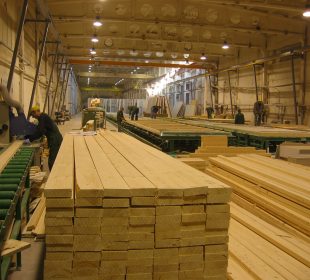All major wood products global production increased for the sixth consecutive year in 2015, while trade in wood products decreased slightly.
According to new data published by FAO recently, the increase was mainly boosted by the continuous economic growth in Asia, a recovering housing market in North America and scaling up of the bioenergy targets.
The increase in the production volume of wood products varied between 1 and 8% in 2015, while the global trade value in primary wood and paper products shrank slightly from $267 billion in 2014 to $236 billion in 2015 due to lower prices for wood products. Production of forest products has been healthiest in Asia-Pacific and North America due to a growing housing market.
Fast growth in OSB wood panels
For the first time, the global figures on Oriented Strand Board (OSB) were introduced in the FAO statistical database, reflecting a growth of 7% in production and trade in 2015 from the previous year. This growth is twice as fast as in the sector of traditional wood panels and sawnwood.
OSB is a type of wood panel commonly used in construction. It is a relatively new product outside of North America where production took off in the 1990s and now growing fast in Europe (including the Russian Federation), while being poised to conquer Asian markets, in particular, China and Malaysia.
"Our data registers a healthy growth in the global production of wood products and a rapid growth in production and trade of relatively new products such as OSB wood panels and pellets, indicating that the forest industry is adapting to changes and has huge potential to become a key player in emerging bioeconomies. Increased use of modern wood-based building materials and energy assortments can contribute to lower net carbon dioxide emissions," said Mats Nordberg, FAO Senior Forestry Officer.
Electronic media driving down demand for graphic paper
Production of graphic paper for publishing and writing, fell 2.3% or by 3 million tons in just one year, reaching its lowest level since 1999. This decrease reflects a widespread global shift towards electronic media and mobile technology. This was particularly the case in North America and Europe, which had already shown a gradual decline in production and demand in previous years, but now other parts of the world are manifesting the same trend.
Recovered paper accounts for more than half (55%) or 225 million tonnes of all fibre used for paper production. This marks a 4% increase since 2013, a 54% increase since 2000, and a 337% increase since 1980.
Trade in pulp and recovered paper jumped by three percent in 2015 also due to production at new export-oriented pulp mills in Brazil and Uruguay recently coming on stream.
EU renewable energy targets supporting the boom in global wood pellet production
Worldwide wood pellet production might blow due to the growing demand for bioenergy, set by the renewable energy targets and policies in Europe.
The wood pellets production jumped to 28 million tons in 2015, a 8% increase over the level in the previous year (26 million tons) and a 47% increase over the 19 million tons from 2012.
The bioenergy demand has resulted in a ten-fold increase in production in the last decade. The Baltic States (Estonia, Latvia, and Lithuania), which produced and exported 3 million tonnes of pellets in 2015, overtook Germany and Canada and together emerged as the second largest producer and exporter of pellets after the US.
According to new data published by the Food and Agriculture Organisation of the United Nations (FAO), in 2015, the Baltic States accounted for 11% of production and 17% of exports globally.
Now, Canada is the 3rd largest pellets exporter and the 4th largest producer after Germany. The markets around the world were dominated by Europe and North America, while Canada and the US accounted for over one-third of global pellet production. At the same time, UK, Denmark and Italy took over 80% of the global pellet imports.

















